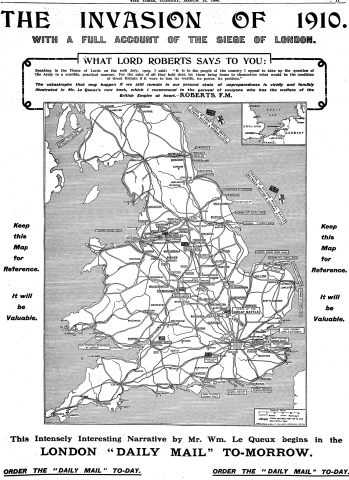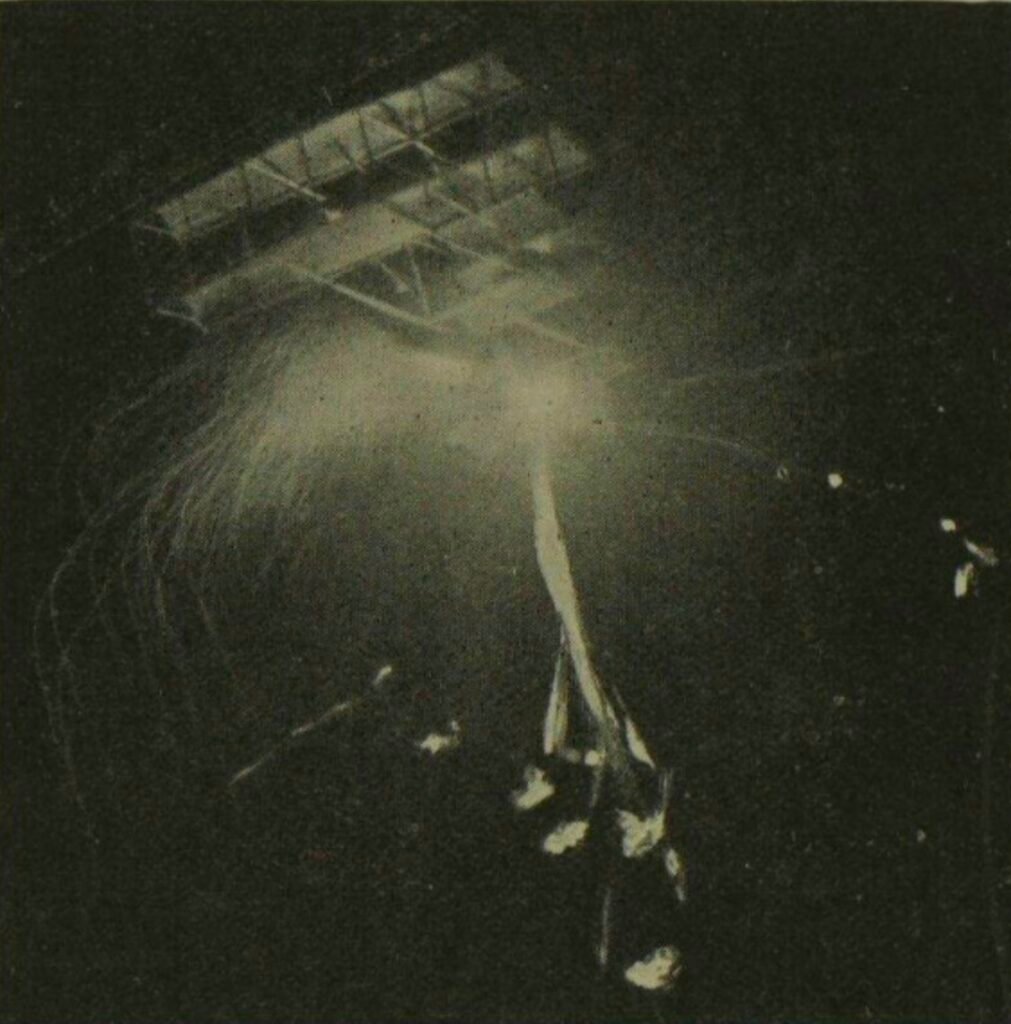William le Queux's The Invasion of 1910 is today one of the best-remembered of the Edwardian invasion novels (at least to anyone interested in the topic). Not because of any literary value -- very few people read it today, and I can't blame them -- but because of its contemporary success. It was commissioned by the press magnate Lord Northcliffe and serialised in his Daily Mail in 1906. And heavily promoted in all his papers, as we can see here -- this is a full page ad from The Times (13 March 1906, 11). The Invasion of 1910 was a huge hit, selling many newspapers and over a million books in a couple of dozen languages, making it the most successful future war story since The Battle of Dorking back in 1871. Northcliffe being Northcliffe, there was also a political objective: the scuppering of the government's proposed Territorial Force, which was widely derided by Conservatives as an ineffective substitute for conscription (sorry, 'national service'). The ad and the book both feature a personal recommendation by Field Marshal Lord Roberts, president of the National Service League.

Here you can see a portion of the map above, showing the German landings in Norfolk and Essex, the unsuccessful defence of London, and its investment, bombardment and sacking. The underlined names are 'Places specifically referred to and described in the text'. Northcliffe apparently ordered the advance of the German army to pursue his circulation objectives rather than follow strategic necessity, though if that's so I wonder why little Oakham is underlined and not nearby Leicester, for example. The rest of the map shows battles between the German and British fleets and the retreat of Parliament from London to Bristol and then Manchester, where it is at the time of the British surrender.
What may be original about le Queux's style here -- it's a few years now since I read most of his competitors so I can't be sure -- is that his narrative is historical or at least journalistic. There are no characters to follow except various generals and politicians as they flit in and out of the story. The book has many more maps along with mock proclamations and newspaper hoardings. It's a campaign narrative of a war that never happened, not an eyewitness account or soldier's tale, and I think this must have been one of the keys to its success (along with the catalogue of fatal mistakes made by and awful fates in store for Britain). And many of the most effective successors to The Invasion of 1910, such as Hector Bywater's The Great Pacific War (1925) and General Sir John Hackett's The Third World War: August 1985 (1978), also used this technique. It's all about the verisimilitude -- it makes it seem like it could happen here, tomorrow, if we don't do something to stop it, today.
![]() This work is licensed under a Creative Commons Attribution-NonCommercial-NoDerivatives 4.0 International License.
Permissions beyond the scope of this license may be available at http://airminded.org/copyright/.
This work is licensed under a Creative Commons Attribution-NonCommercial-NoDerivatives 4.0 International License.
Permissions beyond the scope of this license may be available at http://airminded.org/copyright/.




Erik Lund
Oh, Bobs. When you are arguing the vulgar Whig version of military history, you come in so handy for demonstrating that pre-1914 British generals were all idiotic, conservative cavalrymen. (Two out of three isn't bad, though.)
On a not-entirely unrelated subject, is there a decent biography of Robertson, yet?
Erik Lund
Darn. "Arguing against..." "were not all." Need more coffee.
Ted Samsel
Are you familiar with THE RIDDLE OF THE SANDS? By Erskine Childers. It's part of that genre.
http://en.wikipedia.org/wiki/The_Riddle_of_the_Sands
Brett Holman
Post authorYes, it's about the only one worth reading today for anything other than historical interest, and the only one which is regularly reprinted. I quite like the low-key 1970s film version too, with Michael York as Carruthers.
Ted Samsel
There was an odd little novelistic spin-off from THE RIDDLE OF THE SANDS that came out in the 80's or 90s. I need to find the tiile.
Ted Samsel
It's THE SHADOW IN THE SANDS by Sam Llewellyn. A ripping yarn.
Chris Williams
My brother-out-law, Jim Ring, has written a fine biography of Childers 'n all.
Alex Nordlund
THE GREAT WAR OF 189- (1892) also used a journalistic form to it as well. I'm not sure if you're familiar with it but it has some really interesting war predictions in it for the time it was written.
Brett Holman
Post authorYes, it's one of the better (in the sense of realistic and non-sensational) examples of the genre.
Pingback:
Le Queux’s war | Airminded